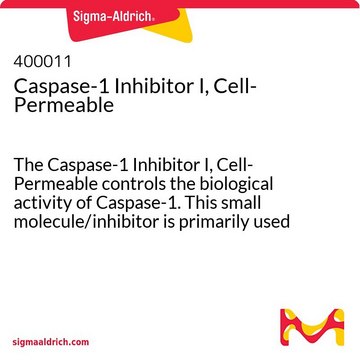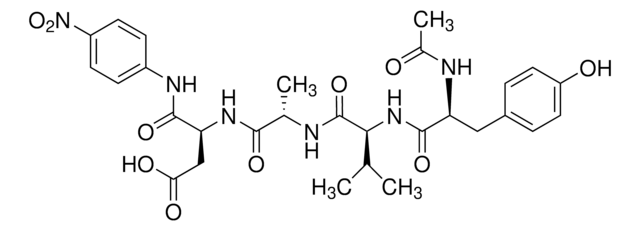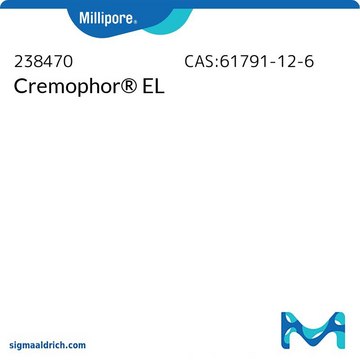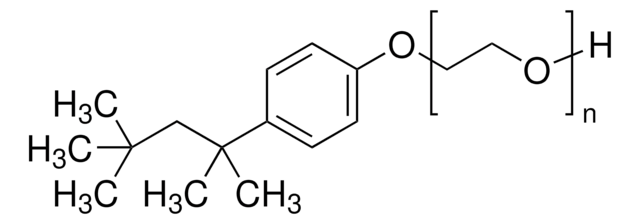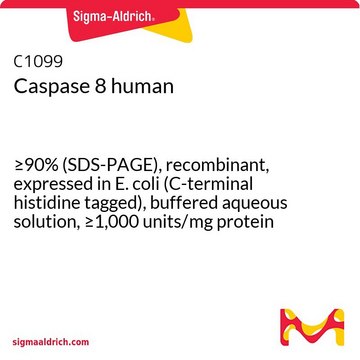C5482
Caspase 1 human
recombinant, expressed in E. coli, ≥5000 units/mg protein
Synonym(s):
ICE, Interleukin-1β-Converting Enzyme
Sign Into View Organizational & Contract Pricing
All Photos(1)
About This Item
MDL number:
UNSPSC Code:
12352204
NACRES:
NA.32
Recommended Products
recombinant
expressed in E. coli
form
powder
specific activity
≥5000 units/mg protein
mol wt
30 kDa
UniProt accession no.
storage temp.
−70°C
Gene Information
human ... CASP1(834)
General description
Research area: Apoptosis
Caspase 1, also called interleukin (IL)-1-converting enzyme, is mapped to human 11q22.3. It belongs to the aspartate-specific cysteine proteases family and is primarily synthesized as procaspase-1 zymogen, which later become catalytically active post autoproteolysis. The enzymatically active caspase-1 comprises two p20/p10 heterodimer making it a tetramer.
Caspase 1, also called interleukin (IL)-1-converting enzyme, is mapped to human 11q22.3. It belongs to the aspartate-specific cysteine proteases family and is primarily synthesized as procaspase-1 zymogen, which later become catalytically active post autoproteolysis. The enzymatically active caspase-1 comprises two p20/p10 heterodimer making it a tetramer.
Application
Caspase 1 human has been used:
- in in vitro cleavage assay with Rab interacting lysosomal protein (RILP).
- in the cleavage of caspases-3/7 in human monocytic cells (THP1).
- in SDS-PAGE for digesting purified protein samples to understand the structural and functional significance of conserved extracellular loop cysteines in the yeast sterol transporter Pdr11p.
- to assess the inhibitory activity of the compounds by conducting a fluorimetric assay using Ac-YVAD-AMC as a substrate.
Biochem/physiol Actions
Caspase 1 catalyzes the conversion of pro-inflammatory cytokine, pro-interleukin (IL)-1β to its active form. It has broad substrate specificity and is an apoptosis regulator. Caspase-1 is indirectly implicated in the pathology of cryopyrin-associated periodic syndrome (CAPS). It is a multiple inflammasome-associated protein associated with multiple sclerosis (MS) lesions and is a prime target for inhibitor screening.
Useful in screening caspase inhibitors, studying enzyme regulation and kinetics, determining target substrate or as a positive control in caspase-1 activity assays.
Unit Definition
One unit will hydrolyze 1 nmol of the caspase substrate, YVAD-pNA to YVAD and p-nitroaniline per hour at pH 7.2 and 37 °C.
Physical form
Powder also contains 0.052% ammonium sulfate, 0.158% Tris HCl, and 0.76% sodium chloride.
Storage Class Code
11 - Combustible Solids
WGK
WGK 3
Regulatory Information
常规特殊物品
Choose from one of the most recent versions:
Already Own This Product?
Find documentation for the products that you have recently purchased in the Document Library.
Caspase-1 inhibition prevents glial inflammasome activation and pyroptosis in models of multiple sclerosis
McKenzie BA, et al.
Proceedings of the National Academy of Sciences, 115(26), E6065-E6074 (2018)
Levente Kollár et al.
Cells, 10(12) (2021-12-25)
Constitutive- and immunoproteasomes are part of the ubiquitin-proteasome system (UPS), which is responsible for the protein homeostasis. Selective inhibition of the immunoproteasome offers opportunities for the treatment of numerous diseases, including inflammation, autoimmune diseases, and hematologic malignancies. Although several inhibitors
Fragment-Sized and Bidentate (Immuno)Proteasome Inhibitors Derived from Cysteine and Threonine Targeting Warheads
Kollar L, et al.
Cells, 10(12), 3431-3431 (2021)
Michael J Romanowski et al.
Structure (London, England : 1993), 12(8), 1361-1371 (2004-08-07)
Caspase-1, a mediator of the posttranslational processing of IL-1beta and IL-18, requires an aspartic acid in the P1 position of its substrates. The mechanisms of caspase-1 activation remain poorly understood despite numerous structures of the enzyme complexed with aspartate-based inhibitors.
Franz Kapplusch et al.
Clinical immunology (Orlando, Fla.), 208, 108232-108232 (2019-06-30)
CASP1 variants result in reduced enzymatic activity of procaspase-1 and impaired IL-1β release. Despite this, affected individuals can develop systemic autoinflammatory disease. These seemingly contradictory observations have only partially been explained by increased NF-κB activation through prolonged interaction of variant
Our team of scientists has experience in all areas of research including Life Science, Material Science, Chemical Synthesis, Chromatography, Analytical and many others.
Contact Technical Service

